Fire and Flood: Grounding disaster, trauma, and emotion
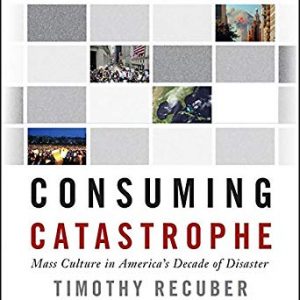 I recently read Sociologist Timothy Recuber’s (2016) book, Consuming Catastrophe: Mass Media in America’s Decade of Disaster. It is a great book, and I loved it particularly for acknowledging that media is not just informational, but involves aesthetic and performative cues for emotional response. Recuber draws on case studies of 9/11, and Hurricane Katrina, among others. His writing is specific to the USA and acknowledges its scope as such.
I recently read Sociologist Timothy Recuber’s (2016) book, Consuming Catastrophe: Mass Media in America’s Decade of Disaster. It is a great book, and I loved it particularly for acknowledging that media is not just informational, but involves aesthetic and performative cues for emotional response. Recuber draws on case studies of 9/11, and Hurricane Katrina, among others. His writing is specific to the USA and acknowledges its scope as such.
As an Antipodean social anthropologist, I am struck by the need for a cross-cultural and de-centred lens on these topics. There is space for ethnographic studies that highlight the locally situated nature of disaster and disaster-response – the way the narratives, symbols, words and meanings that make sense of catastrophes around culturally grounded and particular,
Black Saturday: reviewing art on the anniversary of disaster
 Last week I attended a talk by Dr. Grace Moore, called ‘The Art of Recovery’. Before moving to Otago’s English Department, Dr Moore worked with the ARC (Australian Research Council) Centre for Excellence for the History of Emotions, her research focussing on fire in Australian historical writing and art. But timing and location meant her response also engaged heavily with the devastating Victorian bushfires of ‘Black Saturday’, in 2009. On this 10-year anniversary of the event, she presented some pieces from a collection of art created by survivors.
Last week I attended a talk by Dr. Grace Moore, called ‘The Art of Recovery’. Before moving to Otago’s English Department, Dr Moore worked with the ARC (Australian Research Council) Centre for Excellence for the History of Emotions, her research focussing on fire in Australian historical writing and art. But timing and location meant her response also engaged heavily with the devastating Victorian bushfires of ‘Black Saturday’, in 2009. On this 10-year anniversary of the event, she presented some pieces from a collection of art created by survivors.
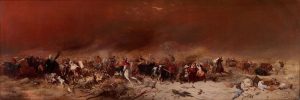
William Strutt’s oil painting ‘Black Thursday’ (1861). Referencing the largest fires ever recorded in Australia, taking place in Victoria 1851.
Dr. Moore’s work makes some fascinating comparisons between this, and 19th century European colonists’ narratives and paintings of bushfire. As such she has been able to highlight some of the moral frameworks and social relationships (i.e. heroism, mateship) that have made sense of bushfires in a culturally-specific way. She notes also that there is a rich tradition of depicting fire among many indigenous Australian communities, which would beg deeper research.
The connection between Moore’s talk and Recuber’s book struck me, in that both addressed representations of disaster (and its aftermath), and also that both discussed the role of emotion and affect as they circulated through particular mediums of communication.
Emotion and trauma: inside, outside, on the page and screen
In Dr. Moore’s talk at the Dunedin Public Art Gallery, art was framed as something used to ‘confront’ and ‘work through’ trauma. It is ‘cathartic’, and ‘therapeutic.’ The vested interest in such processes, after trauma, is not entirely individual. Amidst controversy about accountability and the inadequacies of long-term support, Grace noted the investment of local government in programmes that allow people to ‘channel their emotions’.
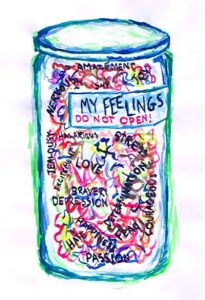 I could also say a lot here, from an anthropological perspective, about the culturally-grounded metaphors of emotion that this all relies on, and in particular the hydraulic metaphors of emotion. These are central to psychodynamic frameworks that emphasise the destructive potential of un-expressed (‘bottled up’) emotions, and the moral and therapeutic values of sharing (‘venting’) emotion.[i]
I could also say a lot here, from an anthropological perspective, about the culturally-grounded metaphors of emotion that this all relies on, and in particular the hydraulic metaphors of emotion. These are central to psychodynamic frameworks that emphasise the destructive potential of un-expressed (‘bottled up’) emotions, and the moral and therapeutic values of sharing (‘venting’) emotion.[i]
I have also written about the distinction between ‘channel’ and ‘vessel’ metaphors of emotion.[ii] In this case I think it is the intersubjectivity of affect that the frequent appearance of ‘channel’ metaphors hint at. They highlight art as not only a personal process but a relational one, a channel for survivors to connect with other people who were not present, across what is often framed as an ineffable void of experience.
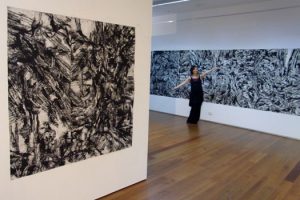
Image from the DAX Centre. Source: http://castlemaineart.com/artists/konii-c-burns/konni-c-burns-dax-centre/
Alternatively perhaps the art itself is the vessel, the receptacle, which holds the emotion channelled into it. Indeed Moore noted that emotion and memories are “embedded” into the work. Regional exhibitions focussed on ‘Recording and Collecting Black Saturday’ and the longer-term efforts of DAX Centre to collect these works (and others by victims of broadly-defined ‘trauma’) could be analysed through this lens. It certainly opens up some interesting questions:
- Do these paintings and sculptures represent the materiality of suffering?
- What then, is the political or moral impetus to hold it and preserve it? To communicate it? To view, experience, or consume it?
There is considerable work still to be done examining the ‘moral economy’ of disaster communication: in mass media, and social media. Recuber’s book includes some particularly interesting work on the ‘digital archives’ that formed around the 9/11 and to Hurricane Katrina. It occurs to me that these, and the exhibitions and collections Dr Moore on, can be seen as a deliberate (and ‘high culture’) institutionalisation of the spontaneous shrine that is increasingly a mark of postmodern collective grief.[iii]
Drawing close to the flame: Empathy and its limits
Recuber talks about the ‘aura’ disaster has; the ‘haunting traces of the real’ that it leaves (p16, 26, 90). Are these possible ways to understand the social practice of collecting and preserving ‘trauma’ art?
Recuber’s idea of ‘empathetic hedonism’ also recalls itself here– “in which the desire to understand the suffering of others is pursued doggedly, through always necessarily unsatisfactorily.” (p9).
Recuber notes particular kinds of ‘stylized and idealized’ empathy evoked by mass media coverage of disaster in the contemporary USA (p19). Once again I believe comparative attention to locally situated forms of empathetic engagement in other places would be beneficial. There are undoubtedly some differences, for example, between the capitalist performative merchandise Recuber describes around the Virginia UniTech Shooter, and the patterns of charity, volunteerism, and witnessing/spectatorship specific to Black Saturday.
Stories (including Dr Moore’s own) of watching weather changes in nearby cities create what appears to me to be a distinctive, embodied, and locally-grounded experience of witnessing, mediated by the sight, smell, and taste of smoke.
In examining art made by children’ affected by the Black Saturday bushfires, Moore also poignantly highlighted the way their experience was often mediated by windows – in cars, as they fled, or in schools where they lived with constant view of devastation after the event. Windows featuring in art are indicative of “intensity, shielding, seeing” she points out. This alludes to a bigger question in the communication of catastrophe – the value (and risk) of seeing. Of empathy itself. The question of vicarious traumatisation.
In my own work with youth workers in Canterbury, after the Christchurch quake, metaphors not only of vessels and channels, but also of boundaries, were common in the stories of care, emotional labour, burnout and compassion fatigue I recorded.
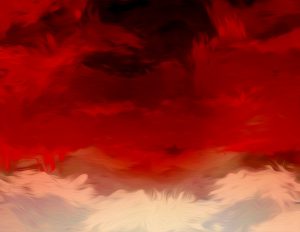
Moore’s talk, I noted, included art by one psychologist who counselled survivors of Black Saturday and framed her art around experiences of “emotion oozing red and sad”. The ‘contagion’ model of emotion is heightened when it is extremely traumatic circumstances in question.
Sometimes keeping the channels, the windows, ‘open’ is experienced as dangerous, overwhelming, even when there appears to be a moral imperative to do so. Other times the desire to draw closer to disaster seems to overcome the distance that is safety. But all of these responses occur in situated local worlds – with their own history, their own geography, and their own socio-political contexts, as Recuber and Moore variously highlight.
In emphasising context and comparison, the anthropological lens has value here too. I am eager to see more work that ‘grounds’ disaster, and the communicative practices it generates, in this way.
Written by: Dr Susan Wardell
References:
[i] Lutz, C., White, G.M., 1986. The Anthropology of Emotions. Annual Review of Anthropology 15, 405–436. https://doi.org/10.2307/2155767
[ii] Wardell, S., 2018. Living in the Tension: Care, Selfhood, and Wellbeing Among Faith-based Youth Workers. Carolina Academic Press.
[iii] Magry, P. & Sanchez-Carretero, C. (2007) ‘Memorializing Traumatic Death’, Anthropology Today, 23(3): 1–2.

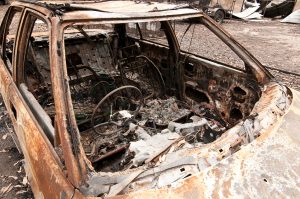
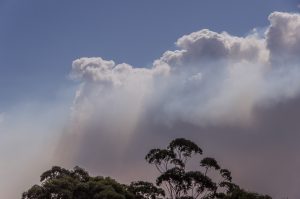

“I did this, and this is anthropology!”: Interning at a Community Non-Profit
Posted on by smisu13p
Though many of us who study social anthropology have a keen interest in helping others, from an uncomfortable seat in a crowded lecture hall it can often be difficult to envision how skills being learnt in the classroom might be applicable in a broader setting.
Here postgrad Social Anthropology student Jordan Webb interviews undergrad student Mika Young[1], about their experience participating in the new HUMS301 humanities internship practicum where they had a chance to translate anthropological theory into ‘real’ world practice at a community organisation; Life Matters Suicide Prevention Trust.
Q. Could you briefly explain the humanities internship paper?
Q. What initially drew you to this internship opportunity?
A. I often find it difficult to communicate with people about what anthropology can offer outside of research. So I thought because I am already interested in pursuing community work after my degree that this paper would be a good chance to learn how anthropology works in a practical sense. To get some experience in the area, and then be able to communicate to other organisations, this is what I have done and this is how I can help you.
Q. How did you use your anthropology major during your placement?
A. I drew a lot from Wollcot’s ‘3 E’s’ – experiencing, enquiring, and examining[2]. I think it is really useful drawing on your own experience, doing the research to make sure you are well informed, and also talking to people and including their experiences. So for the organisations I researched on behalf of Life Matters, it was important to hear their perspectives on their existing training programmes. That’s how I try to see anthropology, and when I am going into an organisation I make sure I’ve covered these three aspects
Q. There has been a lot of talk in the tertiary teaching community about capstone papers which consolidate entire undergraduate experiences, how does this relate to your experience?
A. I’d say very well in the final semester of my degree. That was another motivating factor as I think it helps to bridge between academic and public world beyond, particularly with anthropology as it can be difficult to communicate what your skills are. It gives you an example of, ‘I did this, and this is anthropology’!
Q. How has this experience helped you to communicate the potential applications of anthropology?
A. It’s still a challenge! I think this also a difficulty discipline wide, translating anthropology for a the general public. But it is definitely nice having this concrete example of how a practical task could be approached from an anthropological perspective. For example, one thing that I was able to offer was approaching other organisations and translating the knowledge they had already developed, in combination with my own volunteer experience, and contributing an anthropological understanding of why this information is important. It helps the organisation as much as it helps me, providing them with a new perspective.
Q. What was your overall impression of the internship and paper?
A. I thought the biggest challenge would be making the paper count toward my anthropology major, but that aspect seems to have been quite seamless. In terms of, workload, the initial groundwork and planning took a lot of time and effort, but after that three week period it became a lot easier to manage my own workload as I became more familiar with the role and the organisation.
Q. Would you recommend the paper to other students?
A. Definitely! I think it is good practice to make those conceptual links between what anthropology is in the classroom and how you can apply that to different situations. I think a lot of students struggle because anthropology is so broad, everything can be anthropology if you want it to be! So the paper helps with developing both anthropological skills and real world skills, and being able to keep an open dialogue with organisations about how anthropology can be used to help them.
A. Anyone can do the internship, but being open to adapting, developing communication, and being willing to learn will all add to the value of the paper and the role. The advice I would give to others would be to find an organisation that suits your interests and experience, and find out what works best for you.
***
Many of us are interested in translating anthropology: imagining how we might be able to benefit our communities once we finally graduate! As Mika has suggested, the humanities internship paper might be one of the ways to help negotiate this transition, and to develop and refine ethnographic skills through sharing their application with others.
As Mika remarked, “The tools we are learning are helpful in an academic context but they are also just life skills! It is challenging finding applied uses for anthropology, but ultimately it is about being human, right?”
[1] Mika Young was also the winner of the 2018 Sites Senior Student Essay Competition.Their winning essay is entitled ‘Tā Moko and the Cultural Politics of Appropriation’, and will be published in the 2018 December issue of Sites.
[2] Wolcott, H.F. (2008). Ethnography: A Way of Seeing. 2nd ed. Blueridge Summit: Altamira Press.
Posted in Case study, Curriculum and Pedagogy, Interviews, Media/political commentary, Theory and theorists | Tagged anthropology, Humanities, HUMS302, internship, mental health, non-profit, Otago, students, suicide, suicide prevention, volunteer | Leave a reply